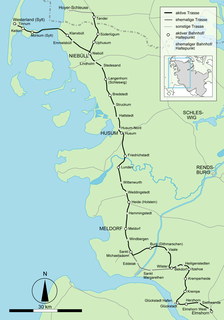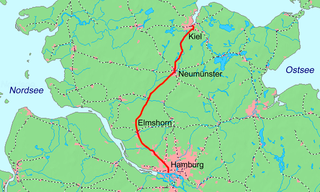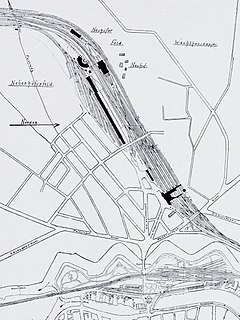
Holstein is the region between the rivers Elbe and Eider. It is the southern half of Schleswig-Holstein, the northernmost state of Germany.

Glückstadt is a town in the Steinburg district of Schleswig-Holstein, Germany. It is located on the right bank of the Lower Elbe at the confluence of the small Rhin river, about 45 km (28 mi) northwest of Altona. Glückstadt is part of the Hamburg Metropolitan Region.

AKN Eisenbahn GmbH operates railway lines, commuter trains and freight trains in Hamburg and Schleswig-Holstein. Its headquarters is in Kaltenkirchen. It is a member of the Hamburger Verkehrsverbund (HVV), which organises public transport in and around Hamburg.

The Marsh Railway is a main line in the state of Schleswig-Holstein in Germany that links the stations of Elmshorn in the south and Westerland on the island of Sylt in the north. It is part of 237-kilometre long (147

The Hamburg-Altona–Kiel railway is the oldest railway line in the German state of Schleswig-Holstein, and the first railway in Denmark or its dependencies at the time, and first to reach the Baltic Sea. Today, it connects Hamburg, Neumünster and Kiel. It is one of the first railways in Germany. When it opened in 1844, Altona and Kiel were the largest cities in the Duchy of Holstein. The line is now owned by DB Netz.

The Neumünster Flensburg Railway is part of the Jutland line, the main north–south rail link through Schleswig-Holstein, Germany. Together with the line to Husum, which diverges in Jübek, and the line to Kiel, which diverges in Rendsburg, it also serves as an important east–west axis between Kiel and the Marsh Railway on the west coast. It consists of several sections that were parts of the first railways in the current territory of Germany.

The Kiel–Lübeck railway is a non-electrified, mostly single-track railway line in eastern Schleswig-Holstein in north Germany. It links Kiel and Lübeck, the only two large cities in the state. Passenger services on the 81-kilometre route are currently (2010) operated by DB Regio.

The Lübeck-Büchen Railway was a German railway company that built railway lines from Lübeck to Büchen and to Hamburg in the 19th century.

The Hamburg–Lübeck railway is one of the most important mainline railways of the German states of Schleswig-Holstein and Hamburg. It connects the two Hanseatic cities of Hamburg and Lübeck, and is part of the line to Denmark. The line was opened in 1865.

The Husum–Kiel railway is a main line railway in the German state of Schleswig-Holstein. While the central section of the line, which is shared with the Neumünster–Flensburg line, has two tracks and is electrified, its western and eastern sections are single track and are not electrified. It connects the cities of Husum and Kiel via Rendsburg and serves as an important east-west rail axis between the North Sea and the Baltic Sea.

The Flensburg–Husum–Tönning Railway Company built the first railway line in the Danish Duchy of Schleswig. The line opened in 1854 and was one of the first Danish railways.

Rendsburg station is located in the city of Rendsburg in the German state of Schleswig-Holstein and is at the junction of the Neumünster–Flensburg and Rendsburg Kiel lines. It is currently operated by Deutsche Bahn, which classifies it as a category 4 station. There used to be a direct line from Rendsburg to Husum via Erfde, as distinct from the current route via Jübek. A short section of the Erfde line is still used for the carriage of freight.

Neumünster station is the main railway station of the town of Neumünster in the German state of Schleswig-Holstein. It is at the junction of lines to Flensburg, Heide, Hamburg-Altona, Kiel, Bad Oldesloe, Kaltenkirchen and until 1985 Ascheberg. It is currently operated by Deutsche Bahn, which classifies it as a category 2 station.

Elmshorn station is a railway station in Elmshorn in Schleswig-Holstein. Here the Hamburg-Altona–Kiel railway (R70) meets the Marsh Railway (R60). Elmshorn is also the terminus of the A3 line of the AKN Eisenbahn. That makes it the third-busiest station in Schleswig-Holstein. The Deutsche Bahn classifies it as a category 3 station and Elmshorn station is in the Hamburger Verkehrsverbund.

The Neumünster–Ascheberg railway runs from the mid Holstein city of Neumünster east to Ascheberg (Holstein) near Plön in the German state of Schleswig-Holstein. The 26 kilometre line is currently closed, although there is a campaign to reopen it.
The Eutin–Neustadt railway was a 16-kilometer-long, non-electrified branch line, running from Eutin to Neustadt in Holstein in the German state of Schleswig-Holstein.

Bordesholm station is a passenger station in the centre of Bordesholm in the German state of Schleswig-Holstein. It is on the Hamburg-Altona–Kiel railway. The station is now mainly used by commuters.
The Neumünster–Heide railway is a single-track, non-electrified railway line the German state of Schleswig-Holstein, connecting the city of Neumünster in central Holstein and Heide, the seat of the district of Dithmarschen.
The West Holstein Railway Company was founded in 1875 with the aim of connecting the west Holstein region in the present-day district of Dithmarschen in the German state of Schleswig-Holstein with the railway junction of Neumünster and beyond with the cities of Kiel and Lübeck. Its creation involved the Kingdom of Prussia, the Altona-Kiel Railway Company, neighbouring villages and towns and the town of Tonning.

Bad Oldesloe station is the most important station of the town of Bad Oldesloe in the German state of Schleswig-Holstein. DB Station&Service assigns it to category 2. It is located on the Lübeck–Hamburg railway, which was opened in 1865. The station has been a rail junction since 1875, when the branch to Neumünster went into operation. The Hagenow Land–Bad Oldesloe and Schwarzenbek–Bad Oldesloe railways followed in 1887 and 1897, but they have since closed. The track of the Elmshorn–Bad Oldesloe railway is only used as an industrial connecting track to Blumendorf for freight. Local public transport is operated by the Stadtwerke Bad Oldesloe, the municipal utility.




















